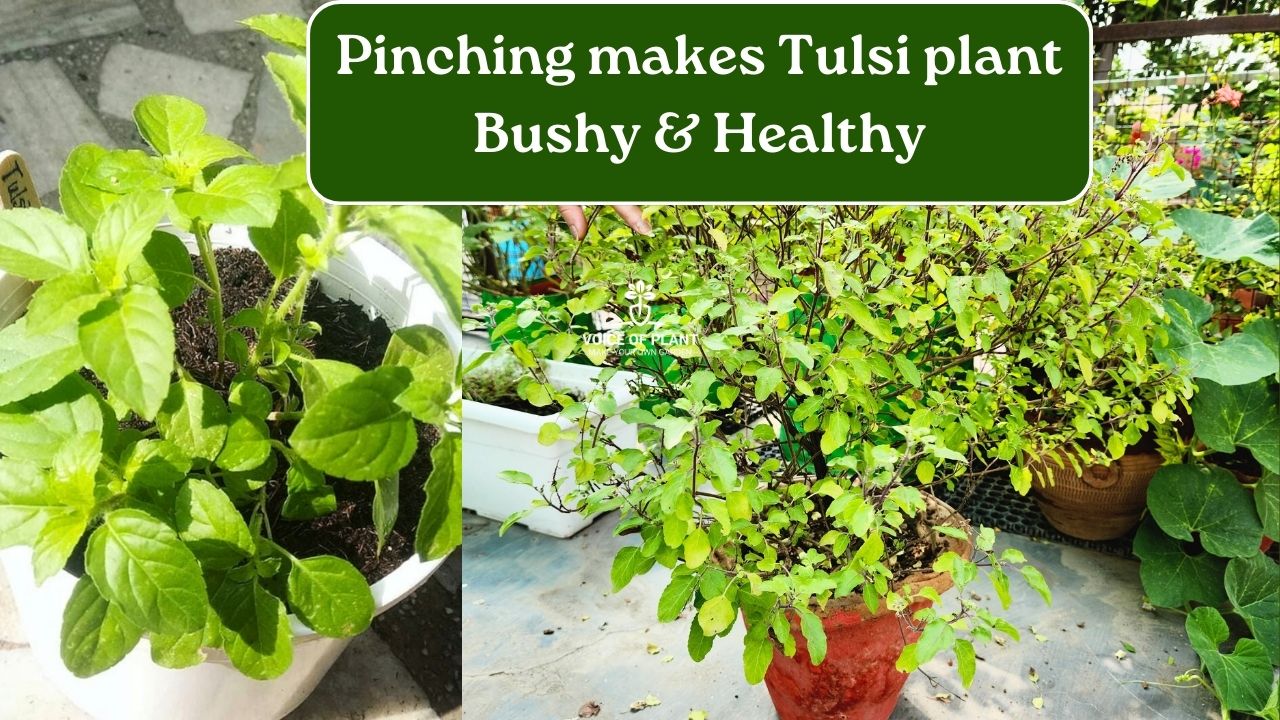7 Easy Tips For Healthy Bushy Green Tulsi Plant
In my garden, I really love my Tulsi plant. Tulsi is more than just a plant—it’s a symbol of purity, health, and natural healing. Growing a healthy Tulsi plant at home is not only rewarding but deeply fulfilling, especially when you understand how to care for it with love and attention.
In my own experience, Tulsi has proven to be a generous and resilient plant. With just a little regular care, it transforms into a beautiful, bushy, and aromatic presence in the garden. Here’s how I take care of my Tulsi plant and how you can do the same!
7 Easy Tips For Healthy Bushy Green Tulsi Plant
🌿Tip 1. The Magic of Weekly Pruning & Pinching
Every week, I gently prune the tops of the Tulsi plants. This practice helps encourage branching and fuller growth before the plant starts producing flowers or seeds.
Tulsi belongs to the mint family (Lamiaceae), which means it naturally grows in pairs—each branch with two leaves at the same point. When we pinch off the top growing tip or central flower stalk, the two side shoots begin to grow vigorously. This results in exponential growth, making the plant bushier and more productive.
Not only does this method give us a healthier plant, but it also provides us with more leaves to harvest for herbal teas and natural remedies.
Tip 2: Choose the Right Pot Size
I always grow my Tulsi plant in a minimum 12-inch clay pot. Why clay pots? Because they are ideal for Tulsi’s growth.
Here’s why:
-
They allow better aeration for the roots.
-
Clay naturally absorbs excess moisture, preventing overwatering.
-
The soil stays cool and breathable, which is great for healthy root development.
🌱 My Tip:
Avoid using small or plastic pots. A small pot restricts root growth, causing the plant to remain weak or dry out quickly. A spacious clay pot encourages a vigorous and bushy Tulsi plant.
Tip 3: Remove Flower Buds (Manjaris)
Tulsi plants love to flower, but allowing them to bloom too early reduces the number of leaves.
How I Care:
I remove flower buds (Manjaris) regularly as they appear.
- This delays blooming, keeps the plant in the leaf-producing stage longer, and ensures the plant stays leafy and green.
Tip 4: Keep the Soil Loose and Well-Aerated
Tulsi thrives in loose, well-drained soil.
🪴 How I Care:
Every 10 to 15 days, I gently till the top layer of the soil. This:
-
aerates the roots,
-
improves water and nutrient absorption,
-
prevents the soil from becoming compacted,
-
supports stronger and deeper root growth.
Secret Tip: Do Not Move Tulsi Plants Unnecessarily
Tulsi plants adapt to their environment. Constantly shifting them from one place to another can stress the plant and hinder growth.
📍 How I Care:
I choose the perfect location for my Tulsi and leave it there to thrive.
- I only move it if absolutely necessary, such as during extreme weather conditions.
Tip 5: Find the Perfect Sunny Spot
Tulsi is a sun-loving plant and thrives best in direct light.
☀️ How I Care:
I keep my Tulsi on a sunny balcony where it gets 6 to 8 hours of direct sunlight daily.
- A south- or east-facing window or open terrace works well too.
Tip 6: Water Only When Needed
Watering Tulsi correctly is essential. Both overwatering and underwatering can damage the plant.
💧 How I Care:
I water my Tulsi only when the topsoil feels completely dry to the touch.
- This prevents root rot and ensures the plant receives just the right amount of moisture.
Tip 7: Feed Organically
Organic nutrition goes a long way in keeping Tulsi vibrant and full of life.
🌿 How I Care:
Every 2 to 3 weeks, I feed my Tulsi with:
-
Cow dung manure
-
Compost tea
-
Or homemade kitchen compost
This keeps the plant healthy, green, and resilient during the growing season.
READ HERE – How To Grow Tulsi Plant From Seeds at Home
🌱 A Sacred Gift of Nature
Tulsi isn’t just a plant—it’s a sacred gift. Revered across cultures for its healing properties, Tulsi blesses us with both health and peace.
- If we care for her gently and consistently, she will reward us with lush greenery and healing energy.
🌱 Final Thought: Love and Patience Matter
Tulsi is a plant that gives back abundantly when cared for properly. These simple yet powerful tips have helped me grow a strong, bushy, and thriving Tulsi plant at home—and they can help you too!
Start small, observe your plant, and nurture it with care. You’ll be amazed at how it responds with lush growth and healing energy.
Take care of this sacred medicine, and she will take care of all of us.
===================
Follow our Social media channel:
1. Voice of Plant – YouTube Channel
2. Voice of Plant Facebook Page
3. Instagram Voice of Plant Channel
Happy gardening!
